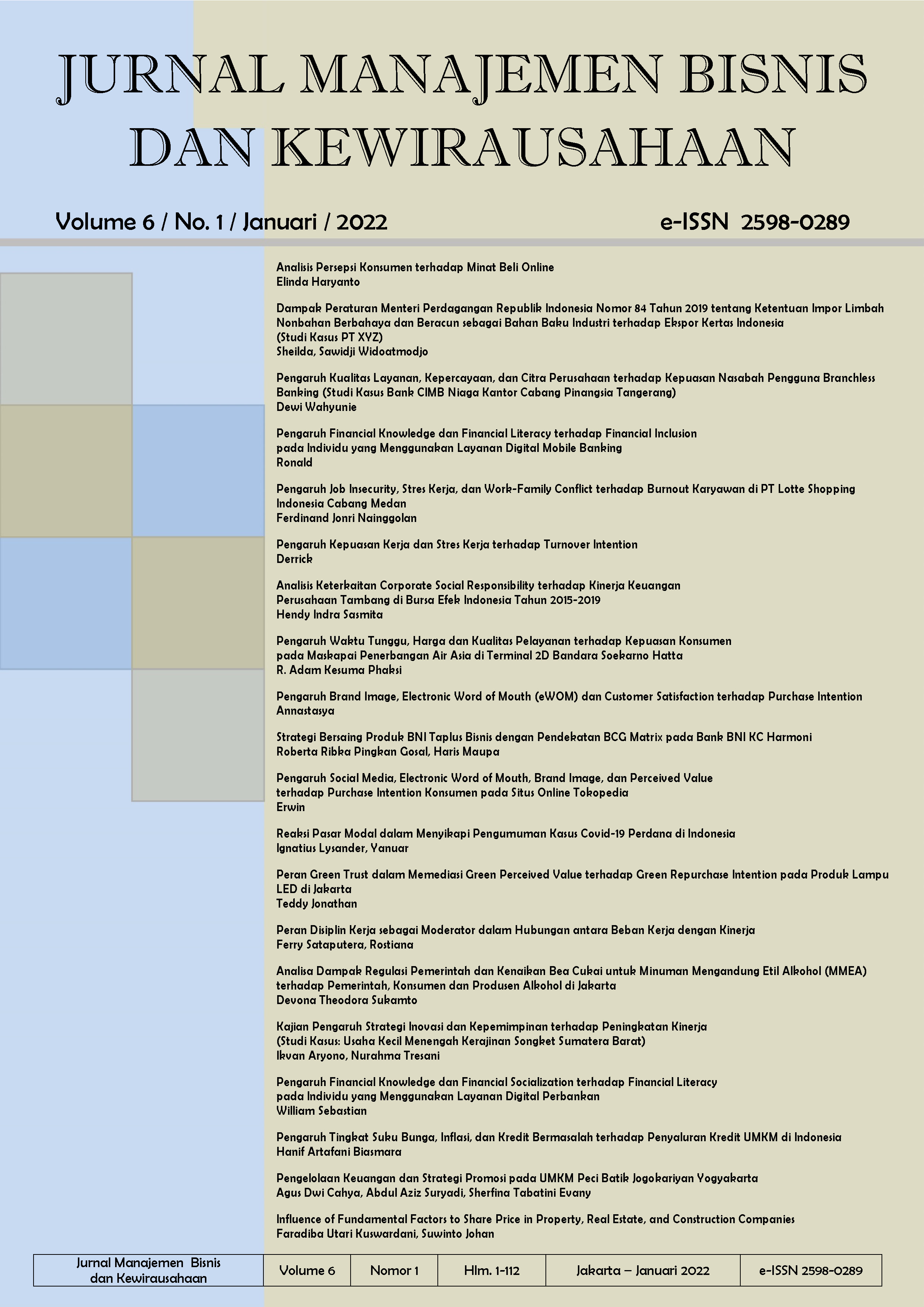Pengaruh Financial Knowledge dan Financial Literacy terhadap Financial Inclusion pada Individu yang Menggunakan Layanan Digital Mobile Banking
Main Article Content
Abstract
The purpose of this research is to identify the effect between financial knowledge and financial inclusion also financial literacy and financial inclusion towards parties who use digital banking system mobile banking in DKI Jakarta. The data in this research was collected through a questionnaire method using Google Form. The research results showed that there is an implication between financial knowledge and financial inclusion also an implication between financial literacy towards financial inclusion.
Tujuan dari riset ini adalah untuk mengidentifikasi pengaruh antara financial knowledge dan financial inclusion juga financial literacy dan financial inclusion terhadap pihak yang menggunakan layanan digital perbankan mobile banking di DKI Jakarta. Data dalam penelitian ini diambil dari metode kuesioner menggunakan Google Form. Hasil penelitian ini menunjukan adanya pengaruh antara financial knowledge dan financial inclusion, juga adanya pengaruh diantara financial literacy terhadap financial inclusion.
Article Details
This work is licensed under a Jurnal Manajemen Bisnis dan Kewirausahaan Creative Commons Attribution-ShareAlike 4.0 International License.
References
Atkinson, A., & Messy, F.-A. (2012). Measuring financial literacy: Results of the OECD INFE pilot study. OECD Working Papers on Finance, Insurance and Private Pensions, 15, 1–73. https://doi.org/10.1787/bb2cd70c-en
Bire, A. R., Sauw, H. M., & Maria, -. (2019). The effect of financial literacy towards financial inclusion through financial training. International Journal of Social Sciences and Humanities, 3(1), 186–192. https://doi.org/10.29332/ijssh.v3n1.280
Chowa, G. A. N., Despard, M. R., & Osei-Akoto, I. (2012). Financial knowledge and attitudes of youth in Ghana (YouthSave Research Brief 12-37). Washington University, Center for Social Development, October 2017, 1–7. https://openscholarship.wustl.edu/cgi/viewcontent.cgi?article=1033&context=csd_research
Fan, J. P. H., Titman, S., & Twite, G. (2012). An international comparison of capital structure and debt maturity choices. Journal of Financial and Quantitative Analysis, 47(1), 23–56. https://doi.org/10.1017/S0022109011000597
Fano, D., Ven, P. van de, Andreasch, M., Matos, J. C. de, Cullen, D., Bonis, R. De, Dippelsman, R., Giron, C., Goebel, P., Hertkorn, A., Lima, F., Mir, A. M., O’Hagan, P., Semeraro, G., Quiros, G., Seneviratne, A., Tebrake, J., Zwijnenburg, J., & Tissot, B. (2017). Understanding Financial Accounts. OECD. https://doi.org/10.1787/9789264281288-en.
Henseler, J., Ringle, C. M., & Sinkovics, R. R. (2009). The use of partial least squares path modeling in international marketing. Advances in International Marketing, 20, 277–319. https://doi.org/10.1108/S1474-7979(2009)0000020014
Hilgert, M. A., Hogarth, J. M., & Beverly, S. G. (2003). Household financial management: The connection between knowledge and behavior. Federal Reserve Bulletin, Jul, 309–322. https://www.federalreserve.gov/pubs/bulletin/2003/0703lead.pdf
Hogarth, J. M., & Hilgert, M. A. (2002). Financial literacy and family and consumer sciences. Journal of Family and Consumer Sciences, 48, 1–7. https://www.consumerinterests.org/assets/docs/CIA/CIA2002/hogarth-hilgert_financial knowledge.pdf
Kaufman, R. (2017). Financial attitude and financial literacy. MyFICO. https://www.myfico.com/credit-education/blog/financial-attitude-and-financial-literacy
Otoritas Jasa Keuangan. (2016). Survei nasional literasi dan inklusi keuangan (SNLIK) 2016. https://www.ojk.go.id/id/berita-dan-kegiatan/siaran-pers/Documents/Pages/Siaran-Pers-OJK-Indeks-Literasi-dan-Inklusi-Keuangan-Meningkat/17.01.23 Tayangan Presscon nett.compressed.pdf
Otoritas Jasa Keuangan. (2017). Salinan surat edaran Otoritas Jasa Keuangan nomor 30 /SEOJK.07/2017. https://www.ojk.go.id/id/kanal/edukasi-dan-perlindungan-konsumen/regulasi/surat-edaran-ojk/Documents/SAL SEOJK 30 - Literasi Keuangan.pdf
Putri, R. A., & Afandy, C. (2020). Dampak dimensi individual financial literacy terhadap financial inclusion pada masyarakat pedesaan. Managament Insight: Jurnal Ilmiah Manajemen, 15(1), 33–48. https://doi.org/10.33369/insight.15.1.33-48
Remund, D. L. (2010). Financial literacy explicated: The case for a clearer definition in an increasingly complex economy. Journal of Consumer Affairs, 44(2), 276–295. https://doi.org/10.1111/j.1745-6606.2010.01169.x
Tustin, D. H. (2010). An impact assessment of a prototype financial literacy flagship programme in a rural South African setting. African Journal of Business Management, 4(9), 1894–1902. https://doi.org/10.5897/AJBM.9000075
van Rooij, M., Lusardi, A., & Alessie, R. (2011). Financial literacy and stock market participation. Journal of Financial Economics, 101(2), 449–472. https://doi.org/10.1016/j.jfineco.2011.03.006
Wold, H. (1985). Partial Least Squares. In S. Kotz & N. L. Johnson (Eds.), Encyclopedia of Statistical Sciences (6th ed., pp. 581–591). John Wiley & Sons.
Xu, L., & Zia, B. (2012). Financial literacy around the world: An overview of the evidence with practical suggestions for the way forward. In Policy Research Working Paper (No. 6107). https://openknowledge.worldbank.org/bitstream/handle/10986/9322/WPS6107.pdf?sequence=1&isAllowed=y


